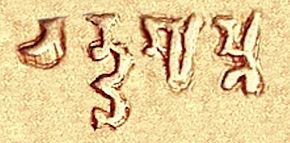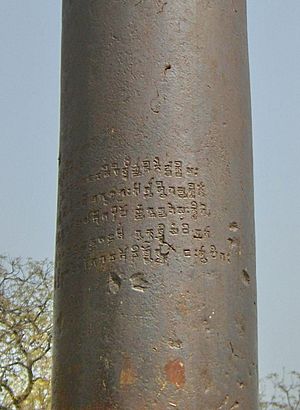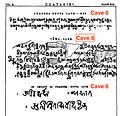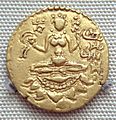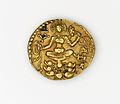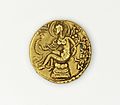Chandragupta II facts for kids
Quick facts for kids Chandragupta II |
|
|---|---|
| Vikramaditya Bhattaraka Maharajadhiraja Deva-raja |
|
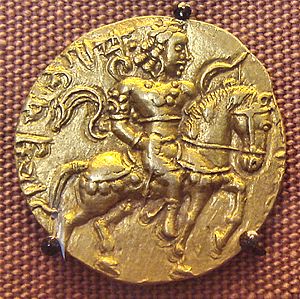
An 8 gram gold coin featuring Chandragupta II astride a caparisoned horse with a bow in his left hand. The name Cha-gu-pta appears in the upper left quadrant.
|
|
| Gupta Emperor | |
| Reign | c. 375 – c. 415 CE |
| Predecessor | Samudragupta, possibly Ramagupta |
| Successor | Kumaragupta I |
| Spouse | Dhruvadevi, Kuberanaga |
| Issue |
|
| Dynasty | Gupta |
| Father | Samudragupta |
| Mother | Dattadevi |
| Religion | Hinduism |
Chandragupta II (r.c. 375-415), also known by his title Vikramaditya, as well as Chandragupta Vikramaditya, was the third ruler of the Gupta Empire in India, and was one of the most powerful emperors of the Indian history .
Chandragupta continued the expansionist policy of his father Samudragupta, mainly through military conquest. Historical evidence suggests that he defeated the Western Kshatrapas, and extended the Gupta Empire from the Indus River in the west to the Bengal region in the east, and from the Himalayan foothills in the north to the Narmada River in the south. His daughter Prabhavatigupta was a queen of the southern Vakataka kingdom, and he may have had influence in the Vakataka territory during her regency.
The Gupta Empire reached its zenith during the rule of Chandragupta. The Chinese pilgrim Faxian, who visited India during his reign, suggests that he ruled over a peaceful and prosperous kingdom. The legendary figure of Vikramaditya is probably based on Chandragupta II (among other kings), and the noted Sanskrit poet Kalidasa may have been his court poet.
Contents
Early life and reign
Chandragupta was a son of Samudragupta and queen Dattadevi. Chandragupta succeeded his father on the Gupta throne.
The king had a distinguished military career. It states that he "bought the earth", paying for it with his prowess, and reduced the other kings to the status of slaves. His empire seems to have extended from the mouth of the Indus and northern Pakistan in the west to the Bengal region in the east, and from the Himalayan terai region in the north to the Narmada River in the south.
Historical and literary evidence suggests that Chandragupta II achieved military successes against the Western Kshatrapas (also known as Shakas), who ruled in west-central India. The exact date of Chandragupta's victory is not known, but it can be tentatively dated to sometime between 397 and 409.As a result of his victory over the Western Kshatrapas, Chandragupta must have extended his empire up to the Arabian Sea coast in present-day Gujarat.
The iron pillar of Delhi contains an inscription of a king called "Chandra". Modern scholars generally identify this king with Chandragupta II, although this cannot be said with complete certainty.
If Chandra is identified with Chandragupta, it appears that Chandragupta marched through the Punjab region, and advanced up to the country of the Vahlikas, that is, Balkh in present-day Afghanistan. However, there is no evidence that Chandragupta annexed Punjab to the Gupta Empire, which suggests that Chandragupta's victory in this region was not a decisive one. There is little evidence of Gupta influence in Punjab after his reign: numismatic evidence suggests that Punjab was ruled by petty chieftains after his death.
The identification of Chandra with Chandragupta II also suggests Chandragupta achieved victories in the Vanga area in the present-day Bengal region. It is possible that a large part of the Bengal region was annexed to the Gupta empire by Chandragupta, and that this control continued into the 6th century.
Chinese pilgrim Faxian visited India during the reign of Chandragupta, and spent around six years in the Gupta kingdom. He was mostly interested in Buddhist religious affairs, and did not bother to record the name of the reigning king. His account presents an idealised picture of the Gupta administration, and not everything he states can be taken at face value. However, his description of the kingdom as a peaceful and prosperous one seems to be generally true. Faxian mentions that other than the untouchable Chandalas, the people did not consume meat, intoxicating drinks, onions or garlic. The Chandalas lived apart from other people, and struck a piece of wood to announce their presence when they entered a city or a marketplace: this would enable other people to avoid contact with them. Only the Chandalas engaged in the fisheries and hunting, and sold meat. In the general markets, there were no butchers' shops, and the people did not keep pigs or fowl. According to historian R. C. Majumdar, Faxian's observations about the people's food habits seem to have been based on his contact with the Buddhist religious community, and may not be applicable to the general public.
Faxian mentions that the people used cowries for buying and selling goods.
Faxian mentions the Pataliputra region as the most prosperous part of the Middle Kingdom, describing its people as benevolent and righteous. He describes an annual Buddhist celebration, which involved a procession of 20 grand carts of Buddhas, the Brahmanas's invitation to the Buddhas to enter the city, and music performances. He mentions that in the cities, the Vaishya chiefs had established centres for dispensing charity and medical help to the destitute. These centres attracted the poor, the orphans, the widowers, the childless, the handicapped, and the sick, who were examined by doctors and given food and medicine until they got better.
Personal life
Gupta records mention Dhruvadevi as Chandragupta's queen, and the mother of his successor Kumaragupta I.
Chandragupta also married Kuvera-naga (alias Kuberanaga), whose name indicates that she was a princess of the Naga dynasty, which held considerable power in central India before Samudragupta subjugated them. This matrimonial alliance may have helped Chandragupta consolidate the Gupta empire, and the Nagas may have helped him in his war against the Western Kshatrapas.
Religion
Many gold and silver coins of Chandragupta, as well the inscriptions issued by him and his successors, describe him as a parama-bhagvata, that is, a devotee of the god Vishnu. One of his gold coins, discovered at Bayana, calls him chakra-vikramah, literally, "[one who is] powerful [due to his possession of the] discus", and shows him receiving a discus from Vishnu.
Chandragupta was also tolerant of other faiths.
Identification with the legendary Vikramaditya
Vikramaditya is a legendary emperor of ancient India, who is characterised as the ideal king, known for his generosity, courage, and patronage to scholars. A number of historians believe that at least some of the Vikramaditya legends are based on Chandragupta II.
Based on some coins and the Supia pillar inscription, it is believed that Chandragupta II adopted the title "Vikramaditya".
The legendary Vikramaditya is said to have defeated the Śaka invaders, and was therefore, known as Śakari ("enemy of the Śakas). Chandragupta II conquered Malwa after defeating the Western Kshatrapas (a branch of Śakas); he also expelled the Kushanas from Mathura. His victory over these foreign tribes was probably transposed on upon a fictional character, resulting in the Vikramaditya legends.
According to most legends, Vikramaditya had his capital at Ujjain, although some legends mention him as the king of Pataliputra. The Guptas had their capital at Pataliputra. According to D. C. Sircar, Chandragupta II may have defeated the Shaka invaders of Ujjain, and placed his son Govindagupta as a viceroy there. As a result, Ujjain might have become a second capital of the Gupta empire, and subsequently, legends about him (as Vikramaditya) might have developed.
Vikram Samvat
Vikrama Samvat, an Indian calendar era beginning in 57 BCE, is associated with the legendary Vikramaditya. However, this association did not exist before 9th century. The earlier sources call this era by various names, including Kṛṭa, the era of the Malava tribe, or simply, Samvat. Scholars such as D. C. Sircar and D. R. Bhandarkar believe that the name of the era changed to "Vikram Samvat" after the reign of Chandragupta II, who had adopted the title Vikramaditya.
Images for kids
-
The pillar inscribed with the Lakulisa Mathura Pillar Inscription, Mathura recording the installation of two Shiva Lingas by Udita Acharya in the "year 61 following the era of the Guptas in the reign of Chandragupta Vikramaditya, son of Samudragupta" (380 CE). Rangeshwar Temple. Mathura Museum. Mathura Museum.
-
The iron pillar of Delhi, which features an inscription of king Chandra, identified as Chandragupta II. It was installed as a victory pillar in the Qutb complex by Sultan Iltutmish in the 13th century.
-
One of the earliest dated Gupta statues, a Bodhisattva derived from the Kushan style of Mathura art, inscribed "year 64" of the Gupta era, 384 CE, Bodh Gaya.
-
Chandragupta II is associated with the development of Vaishnavism in India, and the establishment of the Udayagiri Caves with Vaishnava iconography (here Varaha saving the world from chaos). Circa 400.
-
Silver coin in Western Satraps style (15mm, 2.1 grams.)
See also
 In Spanish: Chandragupta II para niños
In Spanish: Chandragupta II para niños




